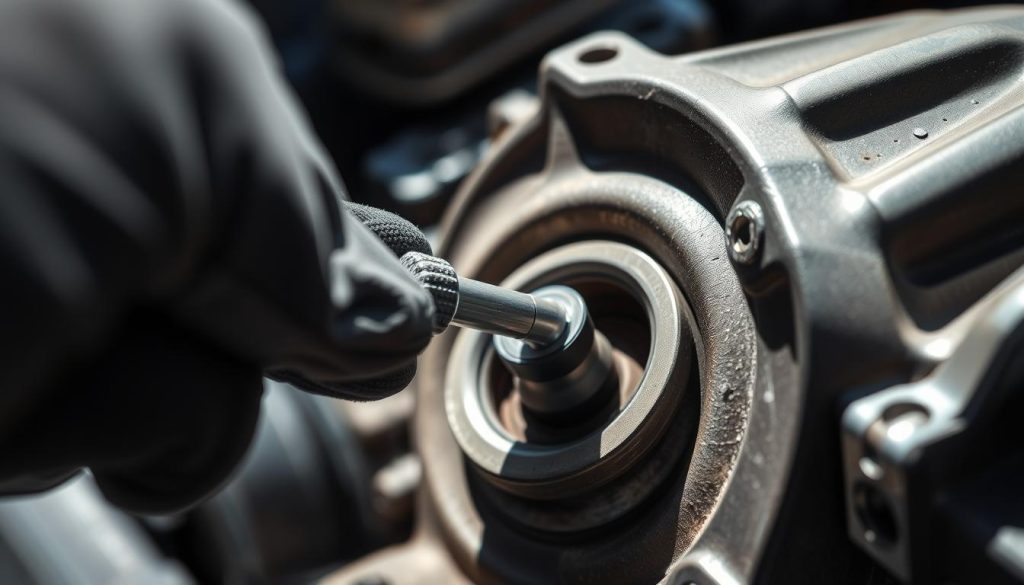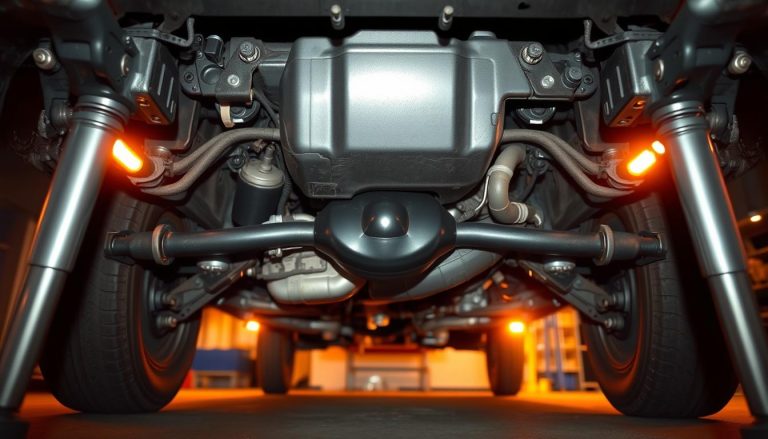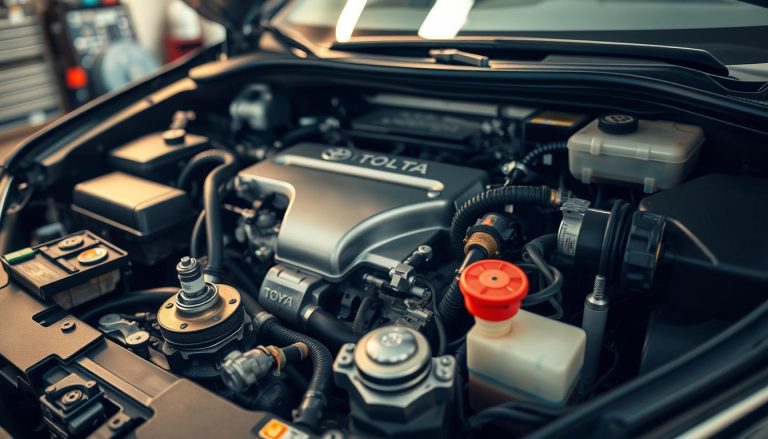Fix Toyota Transmission Slipping – Quick Tips
Dealing with a Toyota transmission slipping can be really frustrating and even dangerous. It’s important for Toyota car owners to know why this happens. This article offers quick tips and solutions to fix transmission slipping fast and effectively.
Our guide covers symptoms, how to start diagnosing, and maintenance tips. Being proactive and knowing about Toyota car trouble can help avoid big problems. This saves you time and money on costly repairs.
Understanding Toyota Transmission Slipping
Transmission slipping in Toyota vehicles means the car can’t stay in one gear. It might shift gears suddenly or feel like it’s slipping out of gear. This problem is dangerous, mainly when driving fast on highways. It’s important to find and fix these issues early to keep your car safe and running well.
What Is Transmission Slipping?
Transmission slipping happens when the car’s transmission doesn’t connect right with the gear it’s supposed to. This can make the car feel like it’s losing power or traction. It shows up as odd gear shifts or the engine revving without moving faster. The car’s transmission works by using fluid pressure, clutch engagement, and gear alignment, all of which need to work together smoothly.
Why Transmission Slippage Occurs
There are many reasons for transmission slippage. Low transmission fluid can cause it because it doesn’t have enough pressure to engage gears. In manual cars, a worn-out clutch system is often the problem. Automatic cars might have issues with faulty clutch plates or solenoids. Neglecting maintenance or not changing fluid on time can lead to these problems, but regular checks and fluid changes can prevent them.
Common Symptoms of Transmission Slipping
Spotting transmission slipping early can save a lot of time and money. Both automatic and manual transmissions show clear signs of trouble. Catching these signs early can prevent bigger problems.
Unusual Gear Changes
Unusual gear changes are a big sign. For automatics, you might see delays when shifting from park to drive. Or, you might get sudden, unexpected shifts while driving.
Manuals might feel less smooth when shifting. Sometimes, the gear might pop out unexpectedly.
Burning Smell
A burning smell means your transmission fluid or clutch might be overheating. This is common in both automatic and manual transmissions. If you smell something burning, act fast to avoid more damage.
Also, look for red transmission fluid under your car. It could mean a leak that’s causing the problem.
Don’t ignore these symptoms. They’re signs that your transmission needs help. If you notice any, get it checked by a mechanic right away.
Initial Steps to Diagnose Transmission Issues
Spotting transmission problems early can save you a lot of time and money. There are a few steps you can take to find out if your car’s transmission is okay.
Check Transmission Fluid Levels
Checking your transmission fluid levels is key to transmission maintenance. Make sure your car is on a flat surface and the engine is warm. Pull out the transmission dipstick, clean it, put it back in, and then pull it out again to see the fluid level. The fluid should be in the marked areas.
Also, look at the color and smell of the fluid. Good transmission fluid is red and smells slightly sweet. If it’s dark or smells burnt, it might mean there’s a problem inside that needs a pro to fix.
Observe Transmission Behavior
Watching how your transmission acts is another way to find issues. Notice if it hesitates, makes strange noises, or feels rough when shifting gears. These signs often mean there’s a problem that needs a mechanic’s help.
Writing down these symptoms can help a lot when you talk to a mechanic. It makes fixing your transmission maintenance faster.
Importance of Regular Transmission Maintenance
Regular maintenance is key to your Toyota’s long life and smooth running. Catching problems like Toyota transmission slipping early can avoid expensive repairs later. Keeping up with maintenance means your car runs better and breaks down less often.
How Often Should You Check Transmission Fluid?
It’s smart to check your transmission fluid every month. Toyota says this to stop slipping and find repair needs early. Keeping the fluid level right and clean is a simple way to keep your car in top shape.
Routine Transmission Inspections
Regular checks on your transmission are a must. Following Toyota’s service schedule can help avoid big problems. These checks look at fluid levels and wear signs. Taking care of your transmission this way can stop costly repairs.
Ways to Prevent Transmission Slipping
Keeping your Toyota’s transmission in top shape is key. By following some simple maintenance tips and driving habits, you can avoid transmission slipping. Here are some essential steps to keep your vehicle’s transmission running smoothly.
Avoid Overheating the Transmission
One major way to prevent transmission slipping is to keep it cool. Overheating can damage the transmission and make the fluid break down. This reduces its ability to lubricate and cool the system.
To avoid this, make sure your cooling system is working well. You might also want to consider adding an extra transmission cooler. This is important if you often tow heavy loads.
Proper Driving Habits
Good driving habits are also vital for Toyota maintenance. Don’t overload your vehicle, as it can stress the transmission too much. Also, try not to accelerate too quickly or stop suddenly.
When driving long distances, take breaks often. This lets the transmission cool down, which is important, even in hot weather.
Regular maintenance checks and careful driving can make your transmission last longer. This means smoother and safer rides. Always get professional checks as part of your regular maintenance routine.
Troubleshooting Automatic Transmission Slipping
Toyota owners facing automatic transmission slipping can try several steps to find and fix problems. Fixing these issues quickly can stop bigger damage and keep your car running smoothly.
First, check the transmission control module (TCM). The TCM controls how the transmission shifts gears. If the TCM has a problem, resetting it might fix the slipping. You can reset the TCM by unplugging the battery for a few minutes and then plugging it back in.
Then, look at the solenoid pack. Solenoids help move hydraulic fluid, which shifts gears. If a solenoid doesn’t work right, it can cause automatic transmission slipping. Check the solenoid pack for wear or damage and replace any bad parts to fix it.
Also, check the electronic control system. This system has sensors and electrical connections that help the transmission work. If sensors or connections are bad, it can mess up the transmission. Use an OBD-II scanner to find error codes related to the transmission and fix the problems they show.
| Component | Function | Potential Issue | Solution |
|---|---|---|---|
| Transmission Control Module | Manages shifting patterns | Software glitches | Reset the TCM |
| Solenoid Pack | Controls hydraulic fluid | Wear or damage | Replace solenoids |
| Electronic Control System | Monitors transmission function | Faulty sensors or connections | Repair or replace components |
By checking these important parts, you can fix automatic transmission slipping in your Toyota. This will help your car run better and last longer. Regular Toyota repair and upkeep are key to avoiding problems and keeping your transmission in good shape.
Troubleshooting Manual Transmission Slipping
Fixing manual transmission slipping problems can be tricky. But knowing the common causes and fixes can save you time and money. This issue often stems from mechanical wear and tear, which needs careful attention.
A worn-out clutch is a main reason for slipping. The clutch connects and disconnects the engine from the transmission. Over time, it can wear out, causing slippage. Look for signs like hard shifting or grinding noises.
Also, misaligned gears can cause slipping. If gears don’t fit right, the transmission slips. Regularly check and adjust the gear linkage for smooth shifting.
Here’s a simple guide to find and fix manual transmission slipping:
- Inspect the Clutch: Check the clutch plate for wear. If it’s worn, you might need a new one.
- Check for Gear Misalignment: Watch how gears change to see if they’re aligned. Adjust them if needed.
- Test the Clutch Pedal: Make sure the clutch pedal moves smoothly and returns easily.
- Examine Transmission Fluid: Some manuals need fluid for lubrication. Check if it’s clean and at the right level.
- Look for External Leaks: Check the transmission case for leaks. Leaks can cause fluid loss and slipping.
Regular maintenance can prevent expensive repairs. Catching problems early can save you money. Also, driving right can help your transmission last longer.
| Common Issues | Signs | Solutions |
|---|---|---|
| Worn-out clutch | Difficulty shifting gears, grinding noises | Replace the clutch plate |
| Misaligned gears | Gear slippage, transmission popping out of gear | Adjust gear linkage |
| Fluid leaks | Visible fluid under the vehicle, slipping gears | Seal the leaks, refill with transmission fluid |
Knowing how manual transmission slipping works and taking steps to prevent it can save you from big repairs. Remember, regular maintenance and catching small problems early can keep your car running well.
How to Check Transmission Fluid
Checking your car’s transmission fluid regularly is key. It keeps your vehicle running smoothly and prevents problems. This simple step helps with better gear shifts.
Steps to Inspect Fluid Levels
- Park your car on a level surface and engage the parking brake.
- Start the engine and let it warm up to the optimal operating temperature.
- Locate the transmission dipstick, commonly found near the engine bay.
- Pull out the dipstick, wipe it clean, and reinsert it fully.
- Remove the dipstick again to check the fluid level. Ensure it is between the “Full” and “Add” marks.
Signs of Contaminated Fluid
Checking the fluid’s condition is part of transmission maintenance. Look out for these signs:
- Discoloration: Fresh transmission fluid is pink or red. If it’s brown, it’s dirty or burnt.
- Unpleasant Smell: A burnt smell means the fluid is overheated and not working right.
- Debris or Sludge: Seeing particles in the fluid means your transmission might be wearing out.
Regular checks help you check transmission fluid and keep your car in good shape. Watch for these signs to catch problems early.
When to Seek Professional Help
Knowing when to get help for your Toyota’s transmission issues is key. It can greatly affect your car’s life and your safety. Here are some times when you should go to a transmission repair shop:
- Repeated Slipping: If your transmission keeps slipping after you’ve tried to fix it, it’s time for a pro to check it out.
- Strange Noises: If you hear grinding or whining from your transmission, it’s a sign of serious problems. A professional repair is needed.
Experts at a transmission repair shop use special tools to find and fix complex issues. They make sure your car gets the right and effective care.
Trying to fix it yourself can cause more harm and cost a lot more later. So, for serious transmission issues, always get help from a professional. This keeps your car running well and safe.
Common Fixes for Transmission Slipping
When your Toyota’s transmission starts slipping, it’s important to act fast. This can stop more damage and save you money. You might need to replace the clutch in manual cars or fix parts in automatic ones.
Replacing the Clutch
A worn-out clutch in manual cars can cause slipping. Look out for hard shifting, odd noises, or a burning smell. Replacing the clutch quickly can make your car last longer and drive safer.
Repairing or Replacing Worn Parts
Automatic cars can slip too, often because of worn parts like bands or solenoids. Finding out which part is bad and whether to fix or replace it is key. Signs like slow shifting, strange noises, or poor performance mean it’s time for a repair.
Here’s a detailed comparison of the parts commonly addressed during a Toyota transmission repair for manual and automatic transmissions:
| Manual Transmission | Automatic Transmission |
|---|---|
| Clutch Replacement | Band Adjustment or Replacement |
| Flywheel Resurfacing | Clutch Plate Replacement |
| Hydraulic System Check | Solenoid Replacement |
Fixing these common issues can make your Toyota run smoothly for years. It’s all about keeping your car in top shape.
Costs Associated with Transmission Repairs
Fixing a slipping transmission can cost a lot, but knowing the price helps you plan. The cost changes based on damage, Toyota model, and repair type. Looking for affordable repairs can help manage costs.
- Extent of Damage: Minor issues like fluid changes or part replacements are cheaper than big repairs.
- Type of Toyota Model: High-end models cost more for parts and labor than standard ones.
- Labor Costs: The time and skill needed for repairs affect the price, with complex issues costing more.
Here’s a table showing estimated costs for different transmission repairs:
| Service Type | Estimated Cost Range |
|---|---|
| Fluid Change | $80 – $250 |
| Minor Repairs (e.g., sensors, seals) | $150 – $450 |
| Transmission Rebuild | $1,200 – $3,500 |
| Transmission Replacement | $2,500 – $5,000+ |
Understanding these costs helps you prepare for repairs and find affordable options. Knowing what to expect can also prevent surprise expenses.
Choosing the Right Transmission Repair Shop
Finding a trusted transmission repair shop is key for your Toyota’s long-term health. Look for a shop with certifications from top automotive groups. A Toyota service center has experts trained for Toyota models, promising top-notch service.
Read online reviews to see how happy other Toyota owners are. Good feedback means you’re likely making a smart choice.
Also, check if the shop is upfront about prices. A good shop will give clear estimates without hidden costs. They should also offer excellent customer service, making the repair process smooth.
Lastly, choose a shop with a strong track record in transmission repair. The more experience they have with Toyotas, the better your service will be. By following these tips, you can be sure your car is in good hands.
What to Expect During a Transmission Repair
When you bring your car in for a transmission repair, knowing the process is key. It shows you how each step is important for fixing your car’s transmission. This makes you feel sure that your car will work well again.
Initial Diagnostic Tests
The first step is finding out what’s wrong with your car’s transmission. Technicians use special tools to check for problems. They look for things like:
- Electronic scans to find error codes
- Visual checks for fluid leaks
- Tests to see how well the car shifts gears
These tests help the technicians know exactly what to fix. This makes the repair process more focused and effective.
Repair Process Overview
After finding the problem, the repair work starts. The steps can change based on the issue. Here’s what usually happens:
- Removing the transmission from the car
- Breaking it down and checking each part for damage
- Cleaning and replacing any parts that need it
- Putting the transmission back in the car
- Testing to make sure everything works right
By doing a thorough check and fixing everything, your car will run like new again. The final test drives make sure the car works well under different conditions. This gives you peace of mind and makes sure your car performs at its best.
Toyota Transmission Slipping Fix: Professional Intervention
Fixing a slipping transmission in your Toyota needs a pro. A Toyota professional repair ensures it’s done right. Technicians at these shops know Toyota models inside out.
Using Original Equipment Manufacturer (OEM) parts is key. These parts fit your Toyota perfectly, lasting longer. Plus, pros use top-notch tools and methods.
Choosing a Toyota professional repair means a detailed check. They find and fix all problems, big and small. Here’s why going pro is better than DIY:
| Aspect | Professional Repair | DIY Repair |
|---|---|---|
| Expertise Level | High | Variable |
| Diagnostic Tools | Advanced | Basic |
| Parts Used | OEM Parts | Aftermarket Parts |
| Warranty | Standard | None |
Going for a Toyota professional repair means peace of mind. Experts who know Toyota transmissions work on your car. This means your car gets the best care, lasting longer and running better.
Conclusion
Understanding transmission slipping and its symptoms is key to fixing Toyota issues. Signs like odd gear changes and burning smells can prevent major damage. Regularly checking fluid levels and driving carefully helps a lot.
Preventive steps are vital. Regular checks and smart driving are part of good car care. For bigger problems, getting professional help keeps your Toyota in top shape. This way, you can avoid high repair costs and find reliable repair shops.
Being proactive with Toyota maintenance helps your transmission last longer. It also makes your drives safer and more reliable. Stay up to date and take good care of your car to keep it running well.
FAQ
What is transmission slipping in a Toyota?
Transmission slipping happens when the gears don’t stay in place. It can shift erratically or feel like it’s slipping without you doing anything. This can cause problems with how the car moves.
Why does transmission slippage occur?
It can happen for a few reasons. Low fluid levels, worn-out clutches, and faulty parts are common causes. Keeping up with maintenance can help avoid these problems.
What are common symptoms of a slipping transmission?
You might notice unexpected gear changes or a burning smell. You could also see delayed gear engagement or jerking during shifts. Red fluid leaks are another sign.
How do I check the transmission fluid levels in my Toyota?
Make sure the engine is warm and the car is on a flat surface. Use the dipstick to check the fluid level. Look for a burnt smell or if the fluid looks dirty.
How often should I check my transmission fluid?
Check it every month. Also, follow the Toyota maintenance schedule for regular checks. This ensures the fluid is at the right level and clean.
What driving habits can help prevent transmission slipping?
Don’t overload your car. Take breaks during long drives to avoid overheating. Make sure the cooling system is working well to keep the transmission healthy.
How can you diagnose issues with an automatic transmission?
Start by checking and resetting the transmission control module. Look for problems with the solenoid pack and any electronic issues that might cause slippage.
What should I do if I have a slipping manual transmission?
Look for mechanical problems like a worn-out clutch or misaligned gears. Regular maintenance and checking for wear are key to avoiding slipping.
When should I seek professional help for transmission issues?
If you notice serious slippage or can’t figure out the problem, get expert help. This is important for safety and keeping your car in good shape.
What are common fixes for transmission slipping?
Replacing the clutch in a manual transmission is a common fix. For automatics, it might involve repairing or replacing parts like bands, clutch plates, and solenoids.
What costs should I expect for transmission repairs?
Repair costs vary based on the damage, your Toyota model, and the needed repairs. Getting an estimate from a certified shop is a good idea.
How do I choose the right transmission repair shop?
Look for certified shops with Toyota expertise. Check customer reviews, pricing, and service quality. This ensures you get reliable repairs.
What should I expect during a transmission repair?
The process starts with diagnostic tests using advanced tools. Then, there are repair stages and final testing to ensure everything works right again.











